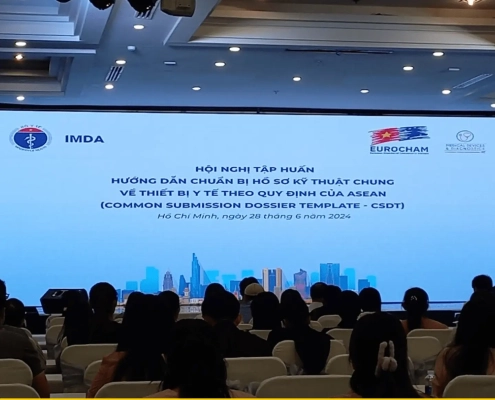Come grow with us in the US in Thailand in China in Korea in the Philippines in Taiwan in Hong Kong
Contact Us
US: +1 512 898-9222
SG: +65 3138-4148
EMAIL: Inquiry@asiaactual.com
How New EU MDR Requirements Will Affect Registrations in Asia
Published on: August 18th, 2022
Implemented in 2021 for new products, the European Union Medical Device Regulations (EU MDR) updated the requirements for medical devices seeking permission to sell in European markets. As manufacturers transition to the new EU MDR requirements, it’s important for regulatory departments to understand the implications of related changes on existing licenses around the world. Fortunately, since most of EU MDR related updates affect labeling and the Instructions for Use (IFU), most manufacturers will be able to address the changes through amendments.
Background Information on the EU MDR
The European Union Medical Device Regulations 2017/745 (commonly known as the EU MDR) were originally published in 2017 and outline the requirements for CE Mark compliance. All medical devices sold in Europe will need to obtain CE Marking from an accredited Notified Body prior to being placed on the market. The EU MDR supersedes the previously enforced regulations: the Medical Device Directive (MDD) and the Active Implantable Device Directive (AIMD). Beginning May 2021, all new CE Marked products have to show compliance to the EU MDR while existing medical devices have until May 2024 to transition to the new compliance requirements.
Some of the EU MDR’s Expanded Requirements
One of the main changes is the implementation of the Unique Device Identifier (UDI) which is expected be implemented to some extent in the vast majority of markets with regulations around the world. According to the EU MDR, all Class III devices should already have a UDI while Class IIa/IIb have until May 2023 and May 2025 for Class I products. Reusable instruments will also need to have the UDI on the actual instrument as well. The compliance date for this requirement is set for 2 years after the labeling requirements go into effect.
Additionally, the EU MDR expands the definition of a medical device to include more products, reclassifies some devices, increases clinical evidence requirements, expands Post Market Surveillance (PMS) requirements, requires manufacturers designate a Person Responsible for Regulatory Compliance (PRRC), and more. While these changes can affect manufacturers documentation and classification, these changes do not require notifying local competent authorities at this time.
How the EU MDR’s Changes Will Affect Licenses in Asia
While each Asian market has their own regulatory nuances, most ASEAN member countries have harmonized with the Medical Device Directive (ASEAN MDD) and will have similar requirements. For the most part, each market will have 2 levels of amendments, typically referred to as “notification” or a “change.” A notification is used for administrative updates while a change, like a Technical Change in Singapore, is usually required for more technical requirements, such as expansions to the indications for use. Since most of the applicable EU MDR-related changes will affect labeling and IFU, the changes can usually be addressed through a notification amendment in the local markets.
Some of the common items that may cause manufacturers to adjust their labeling or documentation include the following items:
- CE Number may be different
- Changing the “Intended use” to “Intended Purpose” per MDR definition.
- Additions of new symbols (according to ISO 15223-1:2021 and generally recognized symbols).
- Clinical Benefit section to the IFU
- Additional performance characteristics per MDR requirements
- Additional assembly information (if applicable)
- Devices shipped to the UK after June 2023 will need to carry a UKCA marking
Manufacturers with existing stock with old labeling can still import with the old labeling but will need to amend their license(s) before importing product with the new labeling and/or IFU.
India Amendment Process
In India, there are two types of amendments available, a Minor or a Major Post Approval Change (PAC). Any change to the product’s labeling or IFU other than changes to its design, color, or layout is considered a Major change. Major PACs, as well as Minor PACs, require approval prior to importation. More than 1 change to the label and/or IFU can be submitted under one application but separate applications will be needed for each product on the Import License. Most Post Approval Changes don’t require review fees but since it’s up to the reviewers, government fees are sometimes required.
For example, a significant change in the intended purpose of an already approved device may trigger the requirement of re-registration with a review fee. Post Approval Changes are typically approved in 3-6 months. With changes in the CE mark, the Indian regulator may check the current Free Sales status in an EU nation (Free Sales Certificate), if the current approval is based on an EU reference.
Changes That Require a Major Post Approval Change
Changes in respect to the following are considered a major change in India:
- material of construction;
- design which shall affect quality in respect of its specifications, indication for use; performance and stability of the medical device;
- the intended use or indication for use;
- the method of sterilization;
- the approved Shelf life;
- the name or address of
- the domestic manufacturer or its manufacturing site;
- overseas manufacturer or its manufacturing site (for import only);
- authorised agent (for import only);
- label excluding change in font size, font type, colour, label design;
- manufacturing process, equipment or testing which shall affect quality of the device;
- primary packaging material.
Thailand Amendment Process
Changes to the labeling or IFU will require a Minor Change in Thailand. Manufacturers are able to submit under the minor change route to update the labeling or IFU as long as it doesn’t affect the efficiency or safety of the medical device such as changing colors, adding/cancelling/changing formats, images, symbols, barcodes or altering text without affecting its overall meaning. Additionally, manufacturers can update the labeling or IFU to improve the safety of the medical device such as adding warnings or precautions. The latest amendment guidance, released in March 2022, is found here.
This process is relatively quick and can be completed in less than a month and costs about US$15 with an additional US$680-850 if a Specialist Review if required.
Minor Changes Permitted in Thailand
Minor changes are available in Thailand, cost about US$15, and are typically approved in one month.
Permitted Minor changes:
- Increase/decrease/change sterilization facilities where the sterilization
process has not changed - Add or remove the list of medical devices in the same medical device group
without changing in a grouping category - Change physical manufacturer, but legal manufacturer/product owner remains
the same. - Name or address of the product owner without changing a physical
manufacturer - Name of physical manufacturer without changing the location
- Decrease shelf life or increase the degree of strictness of storage.
- Update Label or IFU without affecting the efficiency or safety of the medical device
- Update Label or IFU, to improve safety of medical devices like warnings or precautions
- Update Product codes, still the same medical device.
- Software updates that does not affect efficiency and safety of medical device.
Indonesia Amendment Process
Indonesia’s MOH will also require an amendment, locally known as a Variation, to the license for changes to the labeling and IFU. This process is completed within 1o days and requires a fee of US$75. One amendment per license will be required. Indonesia’s Decree of Ministry of Health No. 62 /2017; article no. 30 provides for amending an existing product license to account for changes to packaging dimension, packaging size, labeling (includes IFU), and/or the local license holder’s address. All other product changes would require a new registration submission.
Variations Permitted in Indonesia
Manufacturers can submit a Variation application to an existing product license is any of the following are updated:
- size;
- packaging;
- labelling;
- accessories/annex of the product license; and/or
- name and/or address of representative authorized by Manufacturer.
Any other change will require a new license.
Philippines Amendment Process
Updates to labeling and IFUs will require an amendment, locally referred to as a “Variation” in the Philippines. Fortunately, multiple licenses can be updated with one amendment though a separate review fee of ~US$20 will be assessed for each license amended. For example, a change to the legal manufacturer’s address that applies to 20 CPRs is submitted at one time and will cost US$400. Alternatively, a change to the CE Number and the Manufacturer name will require 2 amendments with 2 fees. Given one STED or CSDT file may lead to multiple licenses in the Philippines, this adjustment to the amendment process greatly simplifies the process. The amendment process requires up to 3 months.
Singapore Amendment Process
Permissible changes to labeling in Singapore is outlined in Flowchart 5 on page 24 of the GN-21: Guidance on Change Notification for Registered Medical Devices. Most labeling and IFU changes will require a 5E, Notification Change which requires about 30 days and a S$530 fee. Anticipating questions, the HSA released MDR-specific guidance in October 2020 to help manufacturers better understand their requirements.
On the other hand, manufacturers choosing to make additional changes beyond the MDR required minor updates may require more complex changes. For example, changes to the warnings, precautions, and/or contraindications may require a Technical Change while rephrasing of existing information or updating the manufacturing information will only require a Notification.
Change Notifications range from no fee and 30 days of review to US$2,075 and 90 days for a Class D Technical change. Multiple changes that fall under the same Change Type can be submitted together under one application. Fees and turnaround times for these various changes is found here.
Vietnam Amendment Process
Non-significant adjustments made to the Vietnamese IFU and label are made through a notification process. The process requires 15 to 30 days to complete.
China Amendment Process
The Chinese NMPA will require manufacturers to submit an IFU change notification for minor changes to the labeling or IFU. The NMPA takes 20 working days to review and does not come with a fee. If the manufacturer does not receive a notice of denial after 20 working days, it can be assumed that the IFU change is approved.
Changing technical information or the intended use is not allowed under this route. If technical information or the intended use is changed, a change application will be required.
Taiwan Amendment Process
Most changes related to the EU MDR’s new requirements will not require an amendment or notification in Taiwan as the TFDA has their own labeling and IFU requirements.
Hong Kong Amendment Process
Any change to labeling will require an amendment in Hong Kong. One amendment per listed device is required and the process will require 3 to 6 months. Hong Kong’s Medical Device Division (MDD) may also check the Chinese translation of the IFU/label to ensure consistency with the English version.
Manufacturer Considerations Prior to Submitting Amendments
Manufacturers selling internationally will likely feel the effects of the EU MDR for a little while as they adjust to the new requirements. It is also recommended that manufacturers consider any other changes coming into effect in the near future. Depending on the expected changes, manufacturers may want to implement multiple changes at the same time to avoid having to submit multiple amendments.
For example, manufacturers may want to include the new UK requirements expected to take effect in 2023. Furthermore, manufacturers with licenses due for renewal in the near future could combine their amendment with the renewal to save costs.
Lastly, manufacturers planning to implement UDI should consider making these changes prior to processing their amendments throughout the region. If you want to learn more about how your specific EU MDR changes affect licenses in different Asian markets, please contact us today.
Come Grow With Us
Please contact us if you’d like support understanding how the new EU MDR requirements might affect your licenses in Asia. Asia Actual specializes in helping medical device manufacturers grow their sales in Asia with experienced, bi-lingual commercial and regulatory experts on the ground in each market. Contact Asia Actual today with any questions or support requests.
Asia Actual is a regulatory consulting company specializing in helping manufacturers grow their sales through independent license holding, direct fulfillment, and a variety of sales channel support services.






